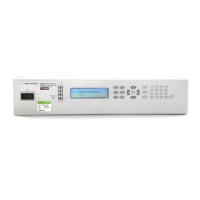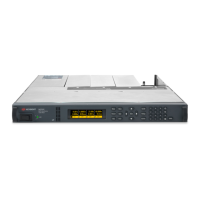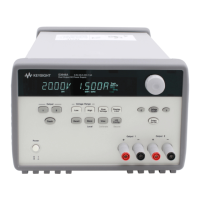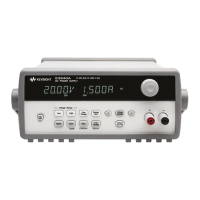Example (300 A load current) You have three 9V units connected in parallel. Two of the units are 1kW
units with a rated current of 100A. The other is a 2kW unit with a rated current of 200A. The load draws
300A of current.
You must first calculate the ideal output current contribution for the 1 kW and the 2 kW units. The ideal
current contribution for the 1 kW unit is calculated as follows:
I
OUT(1KW_IDEAL)
=I
LOAD_TOTAL
/ (N
T
+N
2kW
)
I
OUT(1KW_IDEAL)
=300A / (3+1)
I
OUT(1KW_IDEAL)
=75A
The ideal current contribution for a 2 kW unit is calculated as follows:
I
OUT(2KW_IDEAL)
=2(I
LOAD_TOTAL
) /( N
T
+N
2kW
)
I
OUT(2KW_IDEAL)
=2(300A) / (3+1)
I
OUT(2KW_IDEAL)
=150A
where N
T
= 3, N
1KW
= 2, and N
2kW
=1
Note that the total ideal current equals the total load current: 2(75A) + 150A = 300A
You can now use the gain and offset values for three paralleled units of mixed power (G=0.320%;
K=1.08%) to determine the worst-case deviation from the ideal current for each 1 kW unit. Note that
for a mixed power configuration, the equations use I
2kW_RATING
for both the 1kW and the 2kW
calculations.
∆I
OUT(1KW_WORST_CASE)
=±G(I
OUT(1KW_IDEAL)
) ±K(I
2kW_RATING
)
∆I
OUT(1KW_WORST_CASE)
=±0.32%(75A) ±1.08%(200A)
∆I
OUT(1KW_WORST_CASE)
=±2.4A
Repeat the above step for the 2 kW unit.
∆I
OUT(2KW_WORST_CASE)
=±G(I
OUT(2KW_IDEAL)
) ±K(I
2kW_RATING
)
∆I
OUT(2KW_WORST_CASE)
=±0.32%(150A) ±1.08%(200A)
∆I
OUT(2KW_WORST_CASE)
=±2.64A
4 Using the Advanced Power System
184 Keysight N6900/N7900 Series Operating and Service Guide

